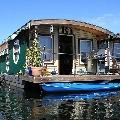This summer, more than 200,000 Americans, according to the U.S. Census Bureau, are on the water - in their homes.
That's right, their homes: flat-bottomed watercraft called houseboats. Many live-aboards, as full-time houseboaters refer to themselves, stay there year 'round. "Three-hundred-sixty-degree waterfront view, and no grass to cut!" a live-aboard named Jim Garrard in Louisville, Kentucky, told us. His wife Linda added, "It's like being on vacation every day." Many houseboats include a kitchen, a head - as mariners call a bathroom -, a microwave oven and a television set attached to an outside satellite dish. One's bedroom is often a fold-out couch or a 3-meter-long bunk. Taking it easy is a houseboating art form. There are the chores of any boat - swabbing the deck, polishing fixtures, draining waste-water tanks, tinkering with the engine, and - once every few years - pulling the boat out of the water to remove freshwater mussels that affix themselves to the hull.
And a houseboat's close quarters, relative lack of privacy and ever-present, faint odor of gasoline aren't for everyone. It's all too easy to fall and break an arm or leg on a slippery deck. And a serious storm can take an unattended houseboat that's lashed to a dock and smash it to bits. But even houseboaters who work elsewhere and have a bad day can come home, sit at the back, or stern, watch the sunset over the water, and relax. Live-aboards admit they don't have all the comforts of home. But they say that serenity and sanity more than make up for what's missing. Read more of Ted's personal reflections and stories from the road on his blog, Ted Landphair's America.

